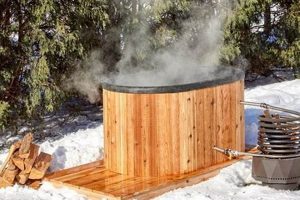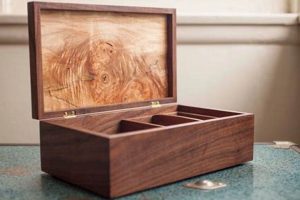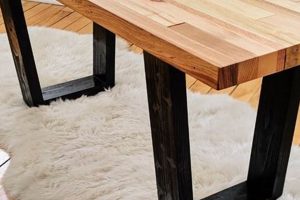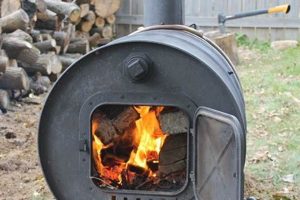Handcrafted wooden structures designed to support candles are a form of decorative art and functional design. These items, often created at home using readily available materials and tools, can range from simple, rustic designs to more complex, artistic creations. For example, a basic design may involve drilling a hole into a block of wood to accommodate a tealight, while a more elaborate project might involve carving intricate patterns or assembling multiple wooden components.
The creation of personalized candle supports from timber offers numerous advantages, including cost savings and the ability to customize the aesthetic to match specific dcor. Historically, wood has been a readily accessible and versatile material, making it a natural choice for crafting utilitarian objects. Furthermore, the act of crafting items from wood can be a therapeutic and rewarding activity, fostering creativity and providing a tangible sense of accomplishment. The use of natural materials aligns with sustainable practices, reducing reliance on mass-produced items.
The following sections will explore different techniques for creating these items, various wood types suitable for their construction, safety considerations for working with wood and fire, and a range of design ideas to inspire individual projects. This will provide the reader with the information necessary to embark on their own crafting endeavors.
Tips for Crafting Wooden Candle Supports
Considerations for achieving successful and safe results in the creation of handcrafted wooden candle supports are outlined below. Adherence to these recommendations is essential for both the aesthetic quality and the functional safety of the finished product.
Tip 1: Wood Selection is Critical. Different wood types exhibit varying levels of hardness, grain patterns, and flammability. Hardwoods such as maple or oak are generally more durable and less prone to ignition than softwoods like pine. Select wood that is free from knots and cracks to ensure structural integrity.
Tip 2: Precise Measurement and Cutting. Accuracy in measurement and cutting is paramount for achieving a balanced and aesthetically pleasing design. Utilize precise measuring tools and employ appropriate cutting techniques to ensure clean lines and uniform dimensions. A miter saw or table saw can be beneficial for achieving accurate cuts.
Tip 3: Proper Sealing and Finishing. Apply a sealant or finish to the wood to protect it from moisture and enhance its durability. Choose a non-flammable finish that is specifically designed for use with wood. Multiple thin coats are preferable to a single thick coat to prevent runs and ensure even coverage.
Tip 4: Consider the Candle Type. The design of the wooden support should be tailored to the type of candle it will hold. Votive candles, tealights, and pillar candles each require different considerations in terms of size, stability, and heat resistance. Ensure the support is appropriately sized and stable for the intended candle.
Tip 5: Incorporate Heat-Resistant Inserts. To mitigate the risk of ignition, consider incorporating heat-resistant inserts into the design, particularly for candle supports intended to hold tealights or votive candles. Metal or glass inserts can provide a barrier between the flame and the wood.
Tip 6: Emphasize Stability. The stability of the candle support is crucial for preventing accidents. Design the base to be wide and stable, and ensure that the candle is securely held in place. Test the stability of the support with a lit candle before leaving it unattended.
Tip 7: Regularly Inspect for Damage. Routinely inspect wooden candle supports for signs of damage, such as cracks, warping, or charring. Discontinue use immediately if any damage is detected to prevent potential fire hazards. Repair or replace the support as necessary.
Adherence to these guidelines promotes the creation of visually appealing and safe wooden candle supports, enhancing both the aesthetic and functional value of the finished product.
Following these guidelines will prepare you for the project’s conclusion, which will summarize all the advice and ideas that have been provided.
1. Wood Selection
The selection of wood constitutes a fundamental decision in the creation of handcrafted wooden candle supports. The inherent properties of different wood species directly influence the structural integrity, aesthetic appeal, and, critically, the fire safety of the finished item. For instance, the density and resin content of a wood determine its resistance to ignition and the rate at which it will burn. Using a high resin softwood, such as pine, without adequate safety measures significantly elevates the risk of fire compared to using a dense hardwood like maple. Consequently, informed wood selection forms the basis for a successful and safe woodworking project.
Practical implications of wood selection manifest in various design and construction choices. If a softwood is selected for its aesthetic qualities, such as the distinct grain pattern of knotty pine, mitigating factors must be implemented. These include the use of metal inserts to isolate the candle flame from the wood, application of fire-retardant coatings, and design modifications to increase airflow and prevent heat buildup. Conversely, hardwoods generally require less mitigation, allowing for greater design flexibility. The choice between a softwood and hardwood also affects the longevity and maintenance requirements of the candle support. Hardwoods are more resistant to scratches, dents, and warping, contributing to a longer lifespan.
Ultimately, wood selection is an inextricable element of the creation of wooden candle supports. A thorough understanding of the properties of different wood types allows for informed decisions that balance aesthetic preferences with critical safety requirements. Neglecting this fundamental aspect increases the risk of fire hazards and compromises the durability of the crafted item. Therefore, careful consideration of wood characteristics is essential for achieving both a visually appealing and functionally safe result.
2. Design Complexity
The level of intricacy in the design of handcrafted wooden candle supports directly affects both the functional demands and the aesthetic outcome. A simpler construction, such as a basic drilled block, requires minimal tools and skill, allowing for rapid production and accessibility for novice crafters. Conversely, a complex design involving joinery, carving, or the integration of multiple components necessitates advanced woodworking techniques and specialized equipment. This increased complexity influences material selection, construction time, and overall project cost. For instance, a design incorporating intricate floral carvings will demand higher-quality wood suitable for detailed work and considerable time investment compared to a simple geometric shape.
The importance of design complexity extends beyond mere aesthetic considerations; it impacts the structural integrity and safety of the candle support. Complex designs involving unsupported overhangs or intricate joints may compromise stability and increase the risk of tipping. Furthermore, complex forms can create pockets of concentrated heat, potentially increasing the risk of ignition, particularly when using softwoods. Real-life examples demonstrate that overly elaborate designs with inadequate structural support have resulted in instability and fire hazards. Therefore, a direct correlation exists between design complexity and the need for careful engineering and material selection.
In conclusion, the choice of design complexity in handcrafted wooden candle supports represents a critical decision, balancing aesthetic aspirations with practical limitations. A more complex design demands advanced skills, specialized tools, and a thorough understanding of woodworking principles to ensure structural stability and safety. While intricate designs can yield visually stunning results, they require significantly greater investment of time, resources, and expertise. Simpler designs, on the other hand, offer accessibility and ease of construction, albeit with a potentially limited aesthetic range. The understanding of this relationship is crucial for successful and safe crafting, ensuring that the final product meets both aesthetic and functional requirements.
3. Safety Precautions
The creation of handcrafted wooden candle supports necessitates stringent adherence to safety protocols. The juxtaposition of flammable material with open flame presents inherent risks, mandating proactive mitigation strategies. Failure to implement appropriate safety measures can precipitate fires, property damage, and personal injury. The correlation between inadequate safety precautions and adverse outcomes is a direct and demonstrably causal relationship. For example, utilizing untreated softwood in close proximity to a candle flame significantly elevates the risk of ignition, whereas incorporating a non-combustible barrier between the flame and the wood mitigates this danger.
Practical application of safety principles involves several key considerations. Wood selection plays a crucial role; hardwoods, being denser and less resinous than softwoods, exhibit a reduced propensity for ignition. Application of fire-retardant coatings provides an additional layer of protection. Design considerations, such as ensuring adequate ventilation around the flame and providing a stable base to prevent tipping, are equally important. Furthermore, the inclusion of a non-combustible liner or insert within the candle recess serves to isolate the flame from the surrounding wood. Regular inspection of the candle support for signs of charring or cracking is imperative, with prompt replacement or repair necessary to prevent escalation of potential hazards.
In summary, the integration of comprehensive safety precautions is not merely an ancillary consideration, but an indispensable component of crafting wooden candle supports. Neglecting these measures constitutes a reckless disregard for potential consequences. Diligent application of fire-resistant materials, thoughtful design, and routine inspection protocols are essential to minimize the inherent risks associated with combining combustible materials and open flame. Prioritizing safety ensures the enjoyment of handcrafted candle supports without compromising personal safety or property integrity.
4. Finishing Techniques
Finishing techniques significantly impact the appearance, durability, and safety of wooden candle supports. The application of appropriate finishes is not merely an aesthetic consideration; it directly affects the wood’s resistance to moisture, scratches, and heat, thereby influencing the longevity and safety of the item. Unfinished wood is susceptible to environmental damage, increasing the risk of warping, cracking, and ignition. Consequently, the selection and application of suitable finishes are critical to the overall quality and functionality of handcrafted wooden candle supports.
The practical implications of various finishing techniques manifest in several ways. Oil-based finishes, for instance, penetrate the wood, enhancing its natural grain and providing some moisture resistance. However, certain oil-based finishes may be flammable and require ample drying time to mitigate fire hazards. Water-based finishes offer lower flammability and VOC emissions but may not provide the same level of moisture protection as oil-based alternatives. Polyurethane finishes create a durable, protective layer but can be less aesthetically pleasing than natural oil finishes. Real-world examples demonstrate that unfinished or improperly finished wooden candle supports are more prone to damage and ignition compared to those treated with appropriate protective coatings. The choice of finish, therefore, must consider both aesthetic preferences and functional requirements.
In summary, finishing techniques represent an integral aspect of crafting wooden candle supports. The selection of appropriate finishes impacts the aesthetic appeal, durability, and, crucially, the safety of the item. Oil-based, water-based, and polyurethane finishes offer varying degrees of protection and aesthetic properties, each with its own set of advantages and disadvantages. Proper application and thorough drying are essential to mitigate fire hazards and ensure the longevity of the finished product. Neglecting this critical step compromises the structural integrity and safety of the wooden candle support, underscoring the importance of informed finishing practices.
5. Candle Compatibility
Candle compatibility represents a crucial aspect in the design and construction of do-it-yourself wood candle holders. This compatibility encompasses the physical dimensions of the candle relative to the holder, the heat generated by the candle, and the potential for ignition of the wood. Incompatible designs pose safety risks, potentially leading to fires or structural damage to the holder itself. The selection of a candle holder design must therefore be directly informed by the specific type and size of candle intended for use. For instance, a large diameter pillar candle placed in a small, poorly ventilated wooden holder creates a significant fire hazard due to concentrated heat buildup.
The implications of candle compatibility extend beyond immediate safety concerns. A well-matched candle and holder will burn more efficiently and safely over an extended period. An appropriately sized holder ensures the candle remains stable, minimizing the risk of spills or tipping. Furthermore, the design of the holder can enhance or detract from the candle’s aesthetic appeal. Examples include the use of metal or glass inserts within the wooden holder to provide a heat-resistant barrier and reflect light, thereby increasing the overall illumination. Considerations of airflow are also important, as insufficient ventilation can cause the candle to smoke or burn unevenly. Proper compatibility maximizes the candle’s lifespan and minimizes the need for constant monitoring.
In conclusion, candle compatibility forms an integral component in the safe and effective utilization of do-it-yourself wood candle holders. It is essential that design choices are made with a clear understanding of the dimensions, heat output, and burning characteristics of the intended candle. Challenges remain in ensuring compatibility across a diverse range of commercially available candle types and in adapting designs to accommodate varying levels of woodworking skill. The ultimate goal remains to create candle holders that are both aesthetically pleasing and functionally safe, enabling the enjoyment of candlelight without compromising safety.
Frequently Asked Questions
The following questions address common concerns and misconceptions regarding the creation and safe usage of handcrafted wooden candle supports. Careful consideration of these points is crucial for ensuring both the aesthetic appeal and the functional safety of these items.
Question 1: What wood types are safest for constructing candle holders?
Hardwoods such as maple, oak, and walnut are generally preferable due to their higher density and lower resin content, which reduces the risk of ignition. Softwoods like pine and fir can be used, but necessitate the incorporation of additional safety measures, such as heat-resistant inserts.
Question 2: Is it necessary to apply a finish to wooden candle holders?
Application of a finish is strongly recommended. Finishes protect the wood from moisture, enhance its durability, and, in some cases, provide a degree of fire resistance. Non-flammable finishes specifically designed for wood are the most appropriate choice.
Question 3: How can the risk of fire be minimized when using wooden candle holders?
Several strategies can reduce fire risk: selecting appropriate wood types, applying fire-retardant coatings, incorporating heat-resistant inserts, ensuring adequate ventilation around the flame, and maintaining a stable base to prevent tipping.
Question 4: What type of candles are most suitable for use with wooden candle holders?
The suitability of a candle depends on the design of the holder. Votive candles and tealights require holders with heat-resistant inserts, while pillar candles necessitate a stable and appropriately sized base. Avoid using excessively large candles that could generate excessive heat or tip the holder.
Question 5: How often should wooden candle holders be inspected for damage?
Regular inspection is essential. Wooden candle holders should be inspected before each use for signs of cracking, charring, or warping. Any damage should be addressed immediately to prevent potential hazards.
Question 6: Are there any specific design considerations for maximizing safety?
Design considerations should prioritize stability, ventilation, and heat isolation. A wide base, adequate airflow around the flame, and the incorporation of non-combustible liners or inserts are crucial for minimizing fire risk.
Prioritizing safety is of paramount importance when crafting wooden candle supports. Diligent application of the principles outlined in these questions ensures the enjoyment of candlelight without compromising personal safety or property integrity.
The next section will provide a summary of best practices for ensuring the longevity and safety of these handcrafted items.
Conclusion
This exploration of diy wood candle holders has underscored critical aspects pertaining to safety, design, and material selection. The preceding sections have illuminated the inherent risks associated with combining wood and open flame, emphasizing the necessity of informed decision-making throughout the crafting process. From selecting appropriate wood types to applying fire-retardant finishes and incorporating heat-resistant inserts, adherence to established safety protocols is paramount. Furthermore, the discussion has highlighted the importance of design considerations, such as ensuring adequate ventilation and stability, to mitigate potential hazards.
The creation of personalized candle supports offers an opportunity for artistic expression and functional design. However, the information presented herein serves as a reminder that safety must remain the foremost priority. Continued vigilance, adherence to established guidelines, and ongoing education are essential to ensure the safe and responsible enjoyment of handcrafted wooden candle supports. Neglecting these principles carries significant risks, underscoring the importance of informed craftsmanship.



![[DIY Guide] Easy DIY Wood Window Shutters You Can Build! The DIY Hub: Creative Crafts, Repairs & Life Hacks [DIY Guide] Easy DIY Wood Window Shutters You Can Build! | The DIY Hub: Creative Crafts, Repairs & Life Hacks](https://craftingdiycenter.com/wp-content/uploads/2025/07/th-3579-300x200.jpg)



